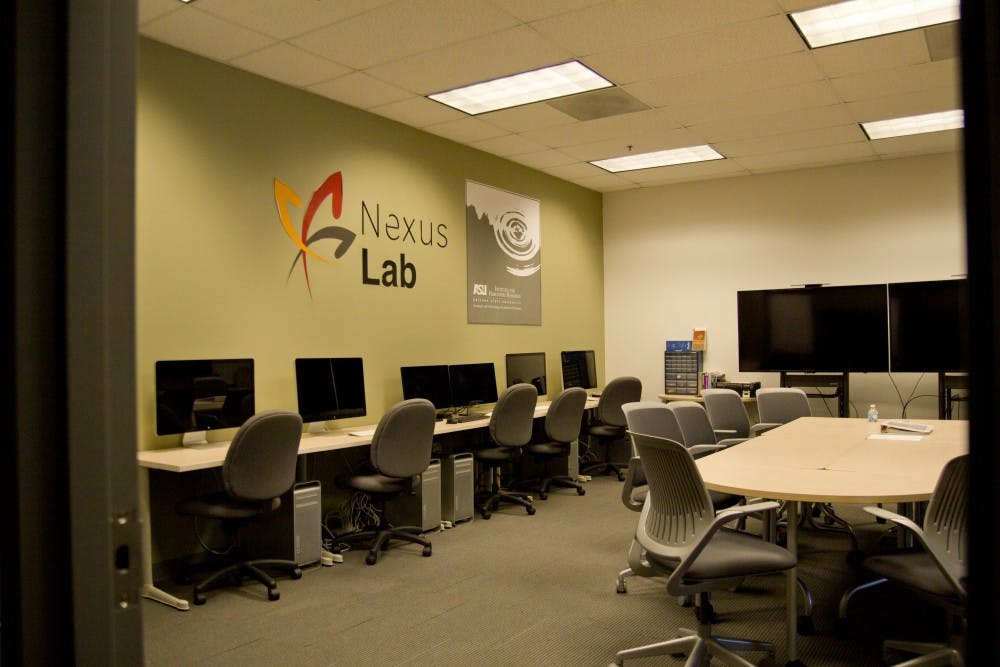 The Institute for Humanities Research Nexus Lab located in the Lattie F. Coor Hall in Tempe. The lab is a place for other interdisciplinary students to come together and collaborate with one another. (Emily Johnson/ The State Press)
The Institute for Humanities Research Nexus Lab located in the Lattie F. Coor Hall in Tempe. The lab is a place for other interdisciplinary students to come together and collaborate with one another. (Emily Johnson/ The State Press)Biking by the Lattie F. Coor Building on the Tempe campus, one could only imagine the type of research contained within the blue-glass exterior. On the fifth floor, a research wing of the Institute for Humanities Research, hums away in a seemingly anonymous wire-infested conference room. This research wing is ASU's IHR Digital Humanities Nexus Lab.
Nexus Lab director Michael Simeone stressed the need for a collective of skilled digital researchers within the New American University in order to raise research capacity.
"Digital facing projects sounds great, but in reality, it’s no different than other kinds of things," he said. "(It's about) making sure you have some kind of robust community of practitioners."
Despite the technical nature of the program, there's a definite connection to the people that actually carry out the research. It is a program centered on humanities, after all.
"For us, it’s much more people driven," Simeone said. "It’s great to learn design thinking, not so that you can just replace a designer, but so that you can be cognizant of design issues and then one day work with a designer.”
In fact, if you haven't picked up on it yet, there's a huge reliance on the collective of talented researchers and thinkers at ASU.
"ASU is an exciting place because it seems like every week you meet somebody new who has a cool idea," Simeone said. "You don’t need to prompt anybody else, everybody’s got great ideas."
One project the IHR Nexus Lab is working with this semester is the Developing Wassaja Project. This project seeks to take a digital magnifying glass to some of Carlos Montezuma's newsletters written about and for the Yavapai tribe of Native Americans in Arizona.
 Michael Simeone, the director of the Institute for Humanities Research Nexus Lab in Tempe. (Emily Johnson/ The State Press)
Michael Simeone, the director of the Institute for Humanities Research Nexus Lab in Tempe. (Emily Johnson/ The State Press)"The Wassaja Project is great because it helps anatomize all those different concerns, and then teach people as they’re working, how to address those things at once," Simeone said. "Not just as individuals, but as a collective of people working together. That’s what makes that a really exciting project for next semester."
David Martinez, professor of American Indian studies, is one of the lead researchers on the Wassaja Project. The collaboration came about after Wassaja team member Jodi Reeves Flores networked with the team at Nexus Lab. The project has two major aims, he said.
"One is digitizing archival material that’s housed in the Labriola Center," Martinez said. "The other is we’re creating an online exhibit of this material complete with a developing scholarly paper and a public event, which is going to be sometime in April."
There's a great synergy between this project and the Nexus Lab, a synergy that will propel the Wassaja Project into a 21st-century research collaboration.
"(The Nexus Lab) can make our project, particularly the online exhibit, more interesting to the academic community, provide features that are useful tools to researchers," Martinez said. "They can help us making it more attractive to a general audience that we couldn’t."
This collaboration is especially important to academics in this day and age because it is so much less paper and binding-centric.
"Because people are scanning and digitizing everything, it’s right at your fingertips," Martinez said. "When it comes to accessing things like documents, images and audio files, it’s been a real boon to researchers."
Working with many different projects, the Nexus Lab prizes the culture-based research the humanities is known for over the potentially less insightful quantitative data, assistant director of Nexus Lab Jacqueline Hettel said.
“Most of those modules are designed to use numeric data and not necessarily data related to implicit concepts or text-based data,” she said.
How the Nexus Lab goes about organizing these many different people and ideas seems complicated, but it comes down to networking in the right way.
"We try to listen to what people need, and not even necessarily what they say they need, but actually listening to what they’re talking about," Hettel said. "When they talk about wanting this, what they’re indicating is that they have this other need."
Once the collaboration is set up, there's the consequence of trying to make, say, a linguist and a computer scientist play well together while trying to solve relevant problems.
"What we’re trying to do, even though our research may have that opposite perspective, we’re trying to garner some of that ying to that yang with some of our colleagues here,” Hettel said.
At the end of it all, there's an implicit understanding that the more powerful insights come from collaboration rather than silos of knowledge that curse old ways of doing research.
"We definitely open it up to everyone, even though we are under the IHR we don’t see discipline,” Hettel said, adding a laugh.
Reach the reporter at pnorthfe@asu.edu or follow him on Twitter @peternorthfelt
Like The State Press on Facebook and follow @statepress on Twitter.




